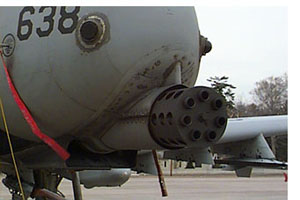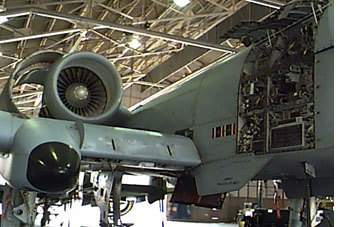
Designed in the late 1970's by Fairchild Republic as the Thunderbolt II, the A-10 is basically a gigantic Gatling gun, occupying most of the fuselage, with seven rotating barrels that shoot bursts of high velocity 30 mm shells - only it can also fly. Powered by twin General Electric engines that deliver up to 9000 pounds of thrust each, the A-10 , although highly maneuverable, is not a fast jet like the more sophisticated, modern fighters and interceptors.
The empty shell casings are collected and recycled in a large tank in the belly of the plane, lest they fly out and get in to the fans of the twin jet engines. Wide open, these guns could expend their total load in just about 20 seconds, but short bursts are usually all that is needed to do the job. Sustained firing would melt the barrels.
The A-10 is not a "fly by wire plane" - it really wants to fly. Modern fighters are so unstable by design that a mere human could not manipulate the controls quickly enough to stay in flight. Computers must monitor and adjust the controls constantly at rates of sometimes thousands of corrections a second. But the long wing span of the A-10 gives it excellent lift and stability. The redundancy of hydraulic and electrical systems keep this bird flying while more sophisticated jets are especially vulnerable to electrical and hydraulic damage in combat. If all the control hydraulic systems fail the A-10 is still able to fly by cables. A-10s have also been known to keep flying and land safely with huge chunks of wing blown away in combat. It's one tough bird.
The present Baltic conflict coincidentally places the A-10 in its originally anticipated theatre of operation, fighting tanks and surface-to-air weapons manufactured and supplied to the former Communist country by Russia. This irony has not escaped the attention of U.S. and NATO commanders. |

 In fact, the A-10 was not designed for either speed or air-to-air conflict. It's total purpose was initially to fly low, to surprise ground troops and tanks, and to deliver its' devastating blasts quickly, to loiter around the battlefield, and then, just as quickly, return to be refitted for another sortie. Super-hard, depleted uranium bullets are used to penetrate tank armor. The gun is fixed and shoots straight ahead. Pilots fly directly towards their targets, often facing flack and other defensive obstacles.
In fact, the A-10 was not designed for either speed or air-to-air conflict. It's total purpose was initially to fly low, to surprise ground troops and tanks, and to deliver its' devastating blasts quickly, to loiter around the battlefield, and then, just as quickly, return to be refitted for another sortie. Super-hard, depleted uranium bullets are used to penetrate tank armor. The gun is fixed and shoots straight ahead. Pilots fly directly towards their targets, often facing flack and other defensive obstacles.  Back when the Soviet threat was overt, NATO strategists envisioned an invading force from Eastern Europe. NATO went as far as positioning A-10s adjacent to long straight sections of the famous German Autobahn, whose middle dividers can readily be removed to transform the superhighway into an excellent launch pad. Another area where land based invasions were feared was in North Korea, and a plan to utilize these unique aircraft in this theater has also kept the A-10 out of mothballs and integrated into part of our country's vital national military assets.
Back when the Soviet threat was overt, NATO strategists envisioned an invading force from Eastern Europe. NATO went as far as positioning A-10s adjacent to long straight sections of the famous German Autobahn, whose middle dividers can readily be removed to transform the superhighway into an excellent launch pad. Another area where land based invasions were feared was in North Korea, and a plan to utilize these unique aircraft in this theater has also kept the A-10 out of mothballs and integrated into part of our country's vital national military assets.